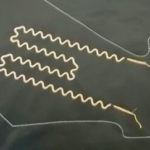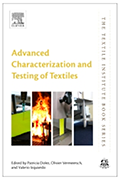
Smart Textiles Testing: A Roadmap to Standardized Test Methods for Safety and Quality-Control (October, 2021)
Chapter of the book “Textiles for Functional Applications” written by Ikra Iftekhar Shuvo, Justine Decaens, Dominic Lachapelle and Patricia I. Dolez.
English version only.
ABSTRACT
Several geomembrane applications involve long-term UV exposure conditions: covers, ponds, leach pads, dams, and canals. High-density polyethylene (HDPE) geomembranes are used in most of these applications. In HDPE geomembranes, UV degradation (photodegradation) induced by long-term exposure to UV or visible light results in discoloration, surface cracks, brittleness, and deterioration in mechanical properties. This paper aims to present specific data from weather stations for the evaluation of light intensity with climates. Weather station data, including irradiance, UV index, latitude, longitude, and altitude, are used to calculate the effective irradiance on HDPE geomembranes. In addition, the orientation to sunlight changes the level of radiant energy on the exposed geomembranes. A model using radiant energy is proposed for guidance to service life prediction of exposed geomembranes.
To learn more, click here.

Smart Textiles Testing: A Roadmap to Standardized Test Methods for Safety and Quality-Control (October, 2021)
Chapter of the book “Textiles for Functional Applications” written by Ikra Iftekhar Shuvo, Justine Decaens, Dominic Lachapelle and Patricia I. Dolez.
Only english version.
ABSTRACT
Test methods for smart or electronic textiles (e-textiles) are critical to ensure product safety and industrial quality control. This paper starts with a review of three key aspects: (i) commercial e-textile products/technologies, (ii) safety and quality control issues observed or foreseen, and (iii) relevant standards published or in preparation worldwide. A total of twenty-two standards on smart textiles – by CEN TC 248/ WG 31, IEC TC 124, ASTM D13.50, and AATCC RA111 technical committees – were identified; they cover five categories of e-textile applications: electrical, thermal, mechanical, optical, and physical environment. Based on the number of e-textile products currently commercially available and issues in terms of safety, efficiency, and durability, there is a critical need for test methods for thermal applications, as well as to a lesser degree, for energy harvesting and chemical and biological applications. The results of this study can be used as a roadmap for the development of new standardized test methods for safety & quality control of smart textiles.
To learn more, click here.

Advanced Characterization and Testing of Textiles, co-authored by Patricia Dolez, Olivier Vermeersch and Valério Izquierdo (CTT Group), provides a comprehensive overview of physical and chemical testing of textiles. By presenting the main principles of characterization and advanced testing, this book goes to the heart of the testing methods specific to each textile property and proves to be a valuable tool for research and development managers in the textile industry, or for students or researchers in textile science.
To learn more, click here.
Long-Term Performance of HDPE Geomembranes Exposed to High Service Temperature, a study by Andrew Mills and David Beaumier (CTT Group) published in the journal Geotechnical Frontiers 2017 looks at the performance of a high-temperature resistant geomembrane evaluated over a one-year period, and compared to the performance of ordinary geomembranes.
To learn more, click here.
Laboratory Measurement of the Linear Thermal Expansion of Geomembranes Using a Dynamic Mechanical Analyzer (DMA)
If you have any questions about this conference, please contact us.
David Beaumier, Patricia Dolez, and Eric Blond, SAGEOS/CTT Group Thermal expansion is a critical property of geomembranes as it can affect the formation of wrinkles during their installation as well as for exposed applications. When an excessive number of wrinkles has developed because of an excessive dilatation of the geomembrane, these wrinkles may become interconnected, which increases the risk and extent of leakage. This paper introduces the test procedure that should be followed to permit the evaluation of thermal expansion characteristics of geomembranes using a Dynamic Mechanical Analyzer. It is shown that the test should be conducted with low applied stress and very low heating rate. In addition, the effect of the specimen width and length is analyzed. Finally, differences in behavior between machine and cross direction are characterized. Overall, it is concluded that this technique provides an effective tool for measuring the linear thermal expansion of geomembranes under conditions simulating their use in the field.
Stress-Cracking Resistance of a Bi-modal PE-RT HDPE Geomembrane
If you want to know more, contact us.
Rohit Sati, M.Sc, Layfield Group, 17720 – 129 Avenue NW, Edmonton, Alberta, Canada; e-mail: rsati@layfieldgroup.com
David Beaumier, Eng., M.Sc.A., CTT Group Sageos, 3000, avenue Boullé, St-Hyacinthe, Quebec, Canada; dbeaumier@gcttg.com
Abstract : Stress crack resistance (SCR) of high-density polyethylene (HDPE) geomembranes, with densities higher than 0.94 g/cc, has been widely researched and documented. Over the years, PE resin technology has evolved and has helped to improve many long-term performance properties including SCR. In this study, resistance to stress-cracking of bi-modal polyethylene raised temperature (PE-RT) HDPE was assessed and compared to HDPE and LLDPE geomembranes over a load range from 28 to 60% of yield stress. The higher tensile resistance of this specific bimodal resin resulted in higher resistance in the ductile failure mode than standard HDPE, but moreover, its stress-cracking resistance behavior was found without any clear transition of the failure envelope from a ductile to a brittle behavior. This observation suggests a longer projected lifespan of this unique bi-modal PE compared to existing geomembranes developed using unimodal resins. Previous studies on this material have analyzed tensile, antioxidant depletion, and resistance to brine and chlorine at elevated temperatures. In all cases, an improvement in durability was demonstrated. This study on stress cracking provides a comprehensive understanding of all known key mechanisms contributing to bi-modal PE geomembrane durability.
Presented at Geosynthetics Conference 2021, Industrial Fabric Association International (IFAI)
Analysis of smart textiles potential application in occupational health and safety – scientific report produced by CTT Group in 2018 for the pour the Institut de recherche Robert-Sauvé en santé et en sécurité du travail (IRSST)
To learn more, click here.
Links to regulatory resources:

